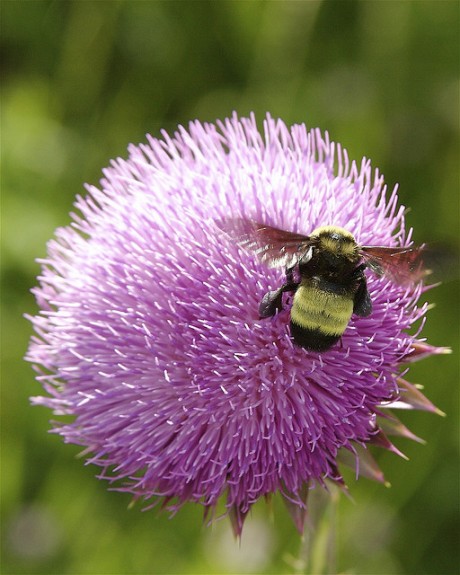The American Bumblebee Is Crashing, Too
Colony Collapse Disorder targets honey bees. But now American bumblebees are missing, too

A “big fuzzy” American bumblebee. Photo: Dan Mullen
You may have heard of a little thing called Colony Collapse Disorder—a “disorder” with no pinned-down cause that leads bees to abandon their hives or get lost on the way home. Beekeepers, says the U.S. Department of Agriculture, report hive population losses of up to 90 percent, but the cause of CCD isn’t definitively known. Possible culprits range from stress to parasites to pesticides to fungus, or a combination of them all. Colony Collapse Disorder, however, has not been affecting all bees—it targets honey bees. But now, says the Associated Press’ Seth Borenstein, bad news for the American bumblebee:
”It was the most dominant bumblebee in the Midwest,” Cameron said, saying it now has pretty much disappeared from much of its northern range. Overall, its range has shrunk by about 23 percent, although it is still strong in Texas and the West, she said.
People call them the big fuzzies,” Cameron said. “They’re phenomenal animals. They can fly in the snow.
A research team who spent weeks in the field cataloguing southern Illinois’ bees could find but one lonely American bumblebee, Borenstein reports. And, the humble bumblebee wasn’t the only thing missing: compared to the observations of a 19th century naturalist, the researchers could find only 54 of 109 expected bee species. The current dearth of bees, he says, could be due to forces similar to those affecting honey bees—”a combination of disease and parasites,” according to the AP.
The absence of bumblebees aligns with previous research described by Smithsonian Magazine‘s Sarah Zielinski a few years ago:
A group of biologists from Illinois and Utah examined the current and historical distributions of eight species of bumblebees from the genus Bombus, looking at thousands of museum records and data from recent nationwide surveys. They found that the abundances of half of those species (B. affinis, B. occidentalis, B. pensylvanicus and B. terricola) have declined by up to 96 percent and their ranges have contracted by 23 to 87 percent in the last 20 years. The other four species, however, remain abundant and widespread.
More from Smithsonian.com:
Honey Bees Still Struggling
Honey Was the Wonder Food That Fueled Human Evolution (And Now It’s Disappearing)
/https://tf-cmsv2-smithsonianmag-media.s3.amazonaws.com/accounts/headshot/smartnews-colin-schultz-240.jpg)
/https://tf-cmsv2-smithsonianmag-media.s3.amazonaws.com/accounts/headshot/smartnews-colin-schultz-240.jpg)